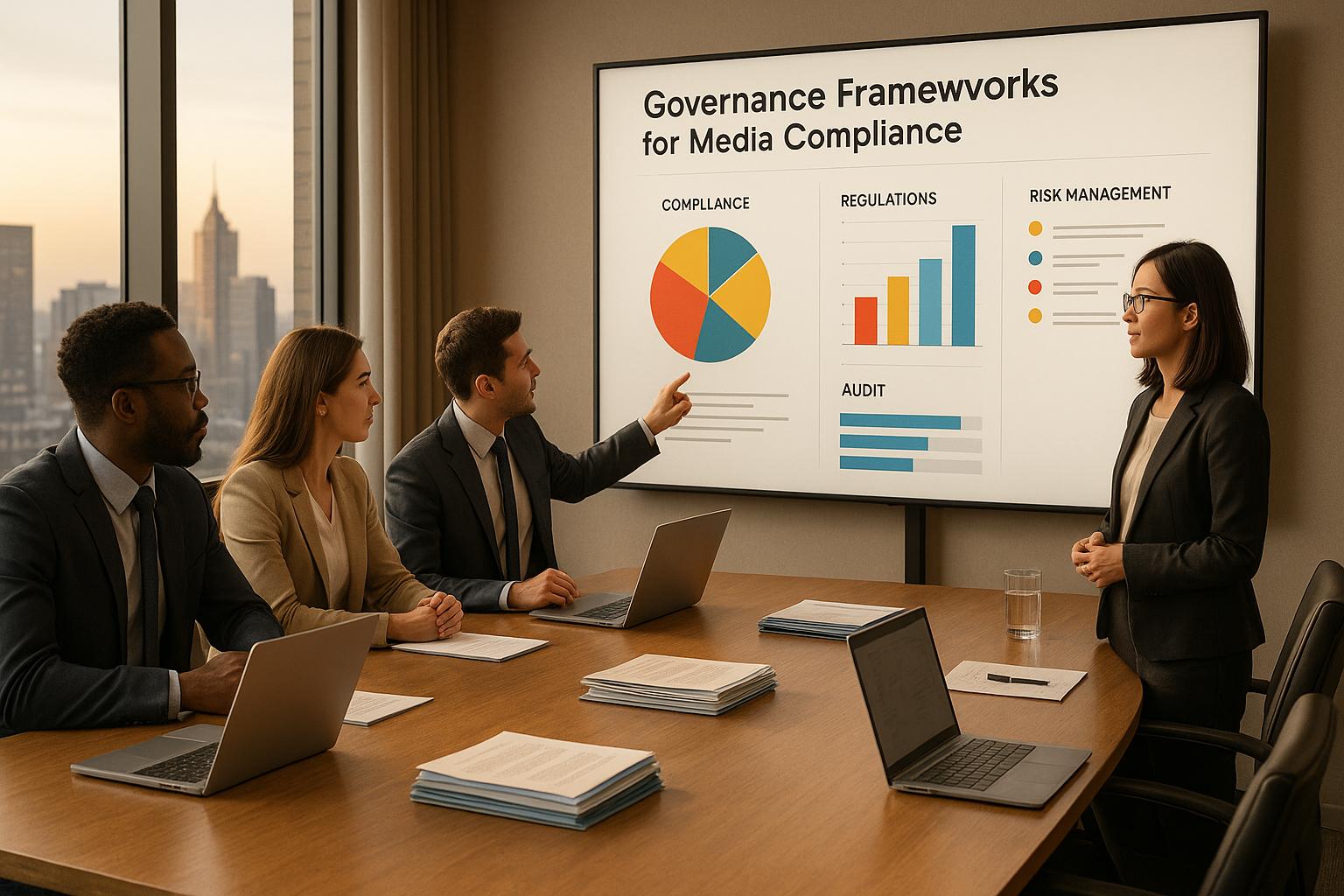Aligning sponsor goals with your business objectives can boost shareholder returns by 5-7% and avoid up to 35% lower ROI from mismatched partnerships. Here's how to create effective sponsorship strategies:
- Set Clear Business Goals: Use SMART objectives and measurable targets like brand awareness, lead generation, or sales impact.
- Evaluate Sponsor Fit: Compare brand values, audience overlap, and execution capacity with a weighted scoring system.
- Design Win-Win Plans: Offer flexible sponsorship tiers and include perks like co-created content or exclusive data access.
- Measure Results: Track ROI with success metrics like financial performance, engagement, and brand impact.
- Build Long-Term Relationships: Use regular communication, performance reviews, and updated terms to maintain strong partnerships.
Strategic Partnerships: How to Manage New Partnerships
Step 1: Set Clear Business Goals
A surprising 58% of sponsors don't set clear objectives for their sponsorships[6]. Yet, companies that define measurable targets are 2.5 times more likely to see strong ROI from their sponsorships[8].
Create Measurable Targets
Set SMART goals - specific, measurable, achievable, relevant, and time-bound. For example, instead of saying "increase brand awareness", aim for something concrete like "achieve 15% growth in brand recognition within 12 months."
| Goal Category | Example Target | How to Measure |
|---|---|---|
| Brand Awareness | 20% boost in social engagement | Analytics tools |
| Lead Generation | 500 qualified leads per quarter | CRM reports |
| Sales Impact | 15% revenue growth from sponsored segments | Sales data |
| Market Position | 10% growth in market share in new regions | Market research |
Review Current Sponsorships
Take a close look at your current partnerships. Use a scoring matrix to evaluate their effectiveness:
| Criteria | Weight | Focus Areas |
|---|---|---|
| ROI Performance | 35% | Financial returns, lead quality |
| Brand Alignment | 25% | Shared values, audience overlap |
| Engagement Metrics | 20% | Interaction rates, audience feedback |
| Strategic Value | 20% | Market access, long-term potential |
Find Partnership Gaps
Look for areas where your sponsorship strategy might be falling short. This involves:
- Market Coverage: Use sponsorship mapping to spot underserved audiences.
- Competitive Analysis: Compare your sponsorships to what competitors are doing.
- Strategic Alignment: Ensure your sponsorships align with broader business goals.
Step 2: Check Sponsor Fit
Once you've set clear business goals, it's time to evaluate potential sponsors. Look at them through three key areas to ensure they’re more than just funders - they should be partners who can help drive growth. This step builds on the groundwork you laid in Step 1.
Compare Brand Values
Assess how well your values align. Look at things like missions, ethical practices, corporate social responsibility (CSR) efforts, and priorities for innovation.
Mastercard's CMO noted that their MLB partnership succeeded because of "aligned fan experience and inclusion goals" that enhanced their brand perception.
Map Target Audiences
Dive into data analytics to see if your audiences overlap. Use these methods to analyze audience compatibility:
| Audience Metric | Analysis Method |
|---|---|
| Demographics | Compare CRM data |
| Industry Focus | Conduct market research |
| Decision Makers | Use LinkedIn audience tools |
| Content Preferences | Analyze social media data |
Score Partnership Potential
Set up a weighted scoring system to evaluate potential sponsors based on these factors:
-
Brand Alignment (40%)
- Shared mission and values
- Ethical compatibility
-
Audience Match (35%)
- Overlap in demographics and key decision-makers
-
Execution Capacity (25%)
- Ability to align marketing channels
- Availability of necessary resources
Step 3: Build Win-Win Sponsorship Plans
Now that you've identified sponsors using Step 2's scoring system, it's time to develop sponsorship packages that benefit both sides. These plans should align with your business goals from Step 1 while addressing any partnership gaps uncovered during sponsor evaluation. Go beyond simple logo placements - focus on creating partnerships that deliver measurable results.
Offer Flexible Sponsorship Tiers
Design sponsorship packages with clear tiers to accommodate different budgets and objectives. According to research, 58% of sponsors prefer tailored packages that meet their specific needs [1]. Here's an example of how you can structure these tiers:
| Tier Level | Investment Range | Core Benefits | Strategic Value |
|---|---|---|---|
| Foundation | $5,000-$10,000 | Basic branding, event access | Entry into the market, visibility |
| Growth | $10,000-$25,000 | Digital exposure, speaking opportunities | Build authority, generate leads |
| Strategic | $25,000+ | Co-creation opportunities, leadership roles | Market leadership, collaboration |
Include Additional Perks
Add extra features to make your sponsorship plans more appealing and aligned with shared goals. Consider offering:
- Joint market research initiatives
- Access to exclusive industry data
- Opportunities for co-developing new solutions
- Executive mentorship programs
- Collaborative content creation
Leverage B2B Ecosystem Tools
Use tools like The B2B Ecosystem's AI Process Optimizer to streamline sponsorship planning. This platform boosts efficiency by 30-40% and increases success rates by 15-20% through data-driven insights [5]. Here's how it can help:
- Analyze past sponsorship performance and forecast ROI for different package setups.
- Suggest optimized configurations for your sponsorship tiers.
- Identify complementary benefits to enhance the value of your offerings.
This approach ensures your sponsorship plans meet both your strategic goals from Step 1 and the expectations of your sponsors, setting the stage for success in Step 4.
sbb-itb-01010c0
Step 4: Measure Results
Tracking sponsorship performance is crucial to ensure it aligns with your business goals. With 78% of sponsors asking for better data[1] and only 19% of professionals effectively measuring ROI[8], defining clear success metrics is key.
Set Success Metrics
Develop a measurement framework that ties sponsorship activities directly to business outcomes. Focus on metrics that show clear value for both sides:
| Metric Category | Key Indicators | Measurement Method |
|---|---|---|
| Brand Impact | Recognition, sentiment, recall | Pre/post surveys, social listening |
| Lead Generation | Volume, quality, conversion rate | Unique landing pages, promo codes |
| Financial Performance | Revenue attribution, ROI | Sales tracking, cost analysis |
| Engagement | Social media activity, event participation | Platform analytics, attendance data |
Create Review Systems
Regularly reviewing ROI can increase the likelihood of renewing partnerships by 38%[8]. Build a system that includes:
1. Monthly Performance Checks
Use automated dashboards to track immediate results. Pull data from CRM tools, social media platforms, and website analytics to get a quick snapshot of performance.
2. Quarterly Strategic Reviews
Hold detailed review sessions with key stakeholders. Assess progress toward shared goals and involve teams from marketing, sales, and finance for a well-rounded evaluation.
3. Annual Partnership Evaluations
Take a deep dive into the sponsorship's overall impact. Compare results to initial goals and industry standards to refine strategies for the future.
Use Data Analysis Tools
Advanced analytics can help you refine sponsorship efforts and maximize outcomes. Consider tools and techniques like:
- Predictive modeling to forecast performance
- Multi-touch attribution to track customer journeys
- Real-time algorithms for on-the-fly adjustments
- Automated dashboards for streamlined reporting
These insights lay the groundwork for Step 5, where relationship-building takes center stage.
Step 5: Build Long-Term Relationships
After analyzing performance insights from Step 4, focus on creating lasting sponsor partnerships. This involves consistent communication and ensuring the partnership continues to align with both sponsor and business goals.
Set Communication Schedule
Consistent, structured communication is key to maintaining strong sponsor relationships. Develop a detailed engagement plan that outlines:
| Communication Type | Frequency | Purpose | Key Components |
|---|---|---|---|
| Status Updates | Monthly | Track performance | KPI progress, campaign metrics |
| Strategic Reviews | Quarterly | Align goals | ROI analysis, market insights |
| Executive Meetings | Bi-annual | Discuss growth plans | Strategic planning, new ideas |
| Real-time Updates | As needed | Share milestones | Success stories, urgent issues |
Research shows that sponsors receiving quarterly updates are 2.5 times more likely to renew their contracts [3]. For example, Coca-Cola’s sponsorship of the Olympic Games thrives on regular engagement, with monthly updates and quarterly reviews ensuring alignment [1].
Prepare for Contract Renewal
Begin planning for contract renewal 6-12 months before the current agreement ends. Focus on demonstrating the partnership’s value and outlining future potential.
"When renewing its partnership with the NFL, Pepsi prepared a comprehensive report showcasing how their sponsorship increased brand awareness by 15% and drove a 10% increase in sales during game days" [2].
A strong renewal strategy should include:
- A detailed analysis comparing initial goals to actual results
- Market research showcasing the partnership’s advantages
- Testimonials and success stories from the collaboration
- Suggestions for new opportunities or improvements for the next term
Update Partnership Terms
As market trends and business objectives shift, partnership terms may need adjustment. For instance, IBM transitioned its tennis sponsorships to focus on digital activations during changing market conditions while maintaining partnership value [9].
When revising terms, consider:
- New opportunities in the market
- Advances in technology
- Shifts in audience behavior
- Ways to deliver added value
- Alignment with updated business goals
Transparent performance tracking and open communication are critical, especially since 87% of sponsors prioritize receiving regular reports [7]. This approach ensures the partnership remains beneficial for both parties.
Conclusion: Keys to Building Strong Sponsor Partnerships
Following these five steps can help organizations develop sponsor relationships that provide real, lasting benefits. Successful partnerships come from blending the outcomes of these steps effectively:
Creating Shared Value
- Offer tailored benefits that align with specific sponsor goals.
- Stay adaptable to shifts in market conditions.
- Prioritize growth that supports a long-term partnership.
Maintaining Clear Communication
Strong communication keeps sponsor relationships thriving through:
- Regular updates on progress.
- Joint sessions to address challenges.
- Actively identifying new opportunities together.
Adjusting Strategies as Needed
Frequent strategy reviews (Step 4) allow partnerships to grow alongside market changes, keeping both sides aligned with shared goals. This approach ensures the relationship remains relevant and beneficial over time.
The foundation of lasting sponsor partnerships is consistent application of these practices, supported by the evaluation methods introduced earlier. By focusing on shared objectives and refining strategies regularly, organizations can create sponsorships that deliver ongoing value for everyone involved.
FAQs
What is the return on investment (ROI) for sponsorships?
ROI depends on the SMART objectives set in Step 1 and varies by sponsorship type. Here's a breakdown of average returns across different industries:
| Industry | Avg ROI |
|---|---|
| Sports Sponsorships | 5:1 - 6:1 |
| Music Festivals | 4:1 - 5:1 |
| B2B Technology Events | 3:1 - 4:1 |
| Cause-related Programs | 2:1 - 3:1 |
To measure sponsorship ROI, focus on these key metrics:
- Financial Impact: Track direct sales and leads generated.
- Brand Metrics: Measure awareness and audience engagement.
- Partnership Value: Evaluate relationships with stakeholders and market access.
For accurate results, use tools like unique tracking codes, surveys, baseline comparisons, and long-term impact studies. Platforms such as The B2B Ecosystem's analytics suite can help consolidate and analyze this data.
Since 2020, digital activations have delivered 20-30% higher returns [9]. ROI timelines vary - events typically show results in 1-3 months, while strategic partnerships may take 2-5 years [4]. Regular performance reviews, as explained in Step 4, are crucial for sustained success.
These practices ensure your sponsorship efforts stay aligned with the goals outlined in Steps 1-3.


